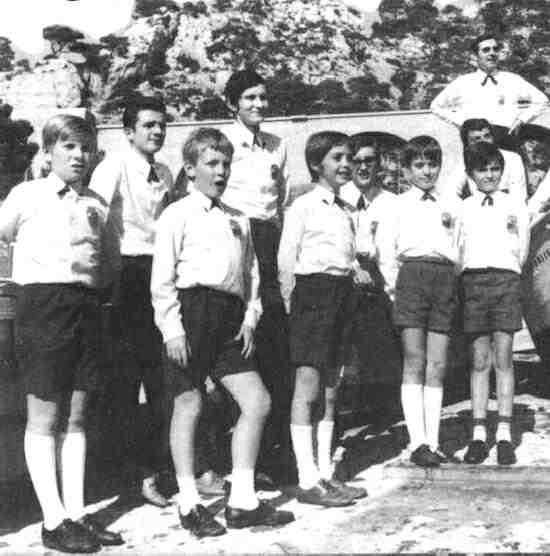
Figure 1.--The boys in this French choir in 1969 wear a kind of cross-tie. We have noted this style pimarily in France. We are not sure what it was called. |

|
We have noted three different types of somehat similar neckwear. They include butterfly ties, actual string ties, bolo ties, and a kind of cross ties. We are not sure what a good generic name for these ties are. We have noted some sources calling tem string ties as a generic term. We will use this term until we can find a more inclusive term.
One alternative to the necktie is a kind of narow ribbon tied into a bow. I am not sure what the English-language term for this, although the term "string tie" is often used in America in modern times. As the ties are not made of string, this seems to us not the best term and ww do not how they were described in the 19th century. The French call it " un noeud papillon ", literaly " butterfly tie ". The French colloquially shorten their noeud papillon to "un pap ". A reader reports that they were called a " dicky bow " in Scotland. The Dutch term is " een vlinderdas " (butterfly tie) or een strikdas (bow tie), informally: een strikje ( a little bow ). The Portuguese term is " uma gravata-borboleta ". The German term is " eine Fliege "or " eine Schleife ". In Austria they were called " ein Mascherl ". They are narrow bow-like ties worn instead of neckties I tend to associate these with the American west in the late 19th century, but perhaps I have seen too many Hollywood Westerns. I am not sure to what extent if any that they were actually worn in the West during the late 19th century. One source does indicate that they were popular in the 1890s. They were also the neckwear of choice of Colonel Harland Sanders of Kentucky Fried Chicken fame. We have noted French boys wearing a very similar styles early in the 20th century, but they were probably worn erarlier. I have not noted modern American boys wearing them. The butterfly ties were worn by English "teddy boys" in the 50s. We have also noted French boys wearing them during the 1950s-70s. We note them, for example, advertized in a 1971 La Redoute catalog. They were worn at some private schools and choirs.
We also note another Western looking neckwear style--the string tie. Since the 1940s this has been worn in the American West, but rarely in the East, by both men ans boys. We also note it was adopted at some French schools after World War II. We note a French school wearing string ties, proabably in the 1970s. We have seen these strung ties being used for buttertie ties, but id they are made of ribbon oe ribbon-like material, I don't think that is correct. narrow necktie in a bow, although Encarata does define it as a "a narrow necktie made of ribbon, tied in a bow".
We notice that some string ties had bollero balls. We notice these beeing worn by both boys and girls in the mid-20th century. The were very popular in both France and Germany in the 1930s, primarily for younger children. Some examples include Hans (Germany, 1938) and the Heim family (Germany, 1939). They seemed to have been more popular for girls than boys, although this varried somewhat from country to country. One example of these bollero string ties appeared in a Soviet fashion magazine. A French reader writes, "About the string ties with little balls. We call the ball in French " Pompon " or sometime " Pompom ". It was considered very fassionable during the first half of the 20th century for babies and often even for older children. They went out of style during the 1960s. Normally the round pompon were worn with wool knit garments. It could be placed in front or on the side. Pompons could be found on wool rompers, wool pants, and sweaters. They were also used on bonnets and gloves. All French mothers were able to made pompon. My wife made nice round pompons for our children, specialy for our son.
It is very easy to make them , 5 minutes are enough to do one.
I never had a string tie as a boy in the 1950s, but I did have a bolo tie with a kind of slide. Oy was a kind of narrow neckwear made from a black cord rather than aribbon and fastened with sliding clip. The slide was metal with some kind of ornamentation. Good quality bolos have slides done in silver with semi-preciious stones like turcoise set in them. This style was also associated with cowboys, although I'm unsure to the extent they actually wore them. Quite a few boys wore them, but of course ties and bowties were much more common. Some times I have noted a reference to bolero ties, but I think the correct term us bolo. Bolero is a short Spanish jacket, and I don't seen the connection there is neckwear associated with it.
I am not sure what the proper name for these tis are. They are appear to be neckwear that crosses just at the front and do not fall down the front like a necktie. Mostly we have seen French boys wearing this style, primarily in the 1950s-70s.
Navigate the Boys' Historical C lothing Web Site:
[Return to the Main necktie page]
[Introduction]
[Activities]
[Biographies]
[Chronology]
[Cloth and textiles]
[Clothing styles]
[Countries]
[Essays]
[Topics]
[Bibliographies]
[Contributions]
[FAQs]
[Glossaries]
[Satellite sites]
[Tools]
[Boys' Clothing Home]
Navigate the Boys' Historical Clothing tie pages:
[Return to the Main bow page]
[Cravat]
[Stock]
[Necktie]
[Bowtie]
[School tie]
